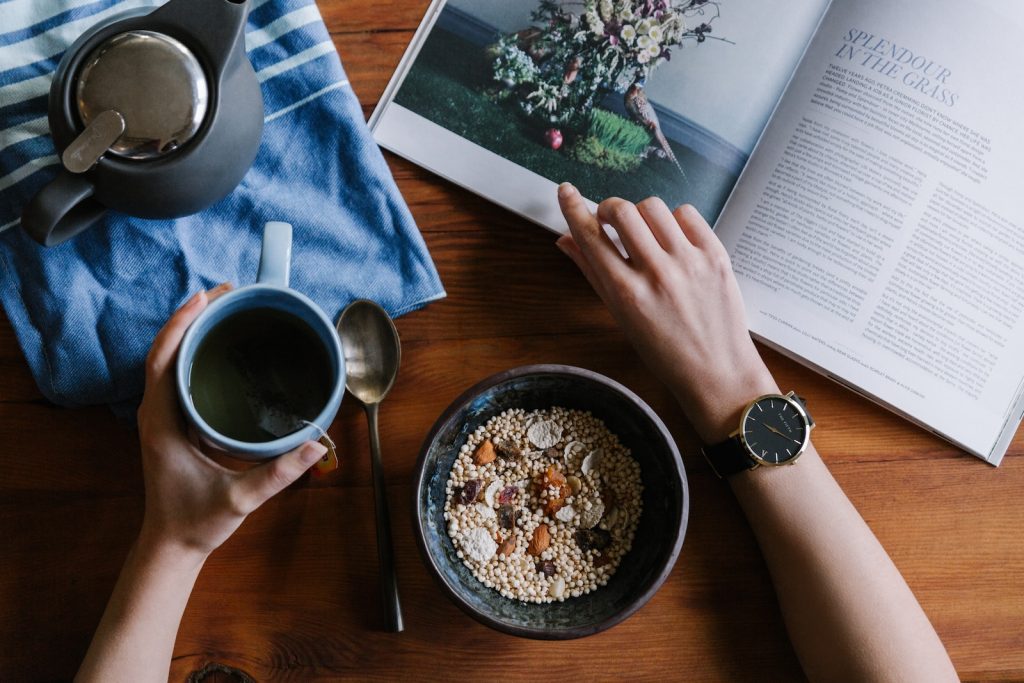This post may contain affiliate links, which means that I may earn a commission if you click on the link, with no cost for you. It’s one of the ways I support my blog. You can read more about this here.
Introduction
Ever wondered how some people seamlessly weave healthy habits into their daily lives, making it look like a walk in the park? Those people didn’t just make those changes overnight, habits take time and practice to form. Habit formation is more than just a routine; it’s a dynamic process that shapes our behaviours over time. Understanding how habits are developed and how they influence our choices is key to achieving sustainable health and fitness transformations. In this post, I want to talk about how habit formation and behaviour change are the keys to a healthier, more balanced lifestyle. Keep reading to understand how habits are formed and how to change your behaviours over time to achieve your goals.

Understanding Habit Formation
How Habits Are Formed
When you find yourself reaching for a snack at the same time every day or putting on your running shoes without even thinking? That’s the cue-routine-reward cycle, the heartbeat of habit formation. First, there’s the cue – a trigger that sets your habit in motion. It could be a specific time, a feeling, or even a particular event. Next comes the routine – the habitual action you take. Whether it’s grabbing an apple or going to the gym, this is the meat of your habit. Finally, the reward – the feel-good moment that seals the deal. Maybe it’s the burst of energy from your snack or the sense of accomplishment after a workout. Understanding this cycle is like having a roadmap for your habits; once you know the route, you can navigate it with intention.
RECOMMENDED READ:
The saying, “practice makes perfect” is spot on when it comes to habits. The more you repeat a behaviour, the more ingrained it becomes in your daily routine. Consistency turns actions into automatic responses. It’s not about perfection; it’s about showing up regularly. Whether you’re aiming to drink more water or move more, the key is to make it a regular part of your day. Over time, these repeated actions carve out neural pathways in your brain, making your habits not just something you do but a part of who you are.

The Habit Loop
- Cue: The Trigger
- The initial spark that kicks off the habit loop
- Can be a specific time, emotion, or event
- Acts as the signal for your brain to initiate the routine
- Routine: The Habitual Action
- The conscious and repeated behaviour you engage in
- Can include activities like workouts, healthy snacks, or other positive behaviours
- The central part of the habit loop where you actively participate
- Reward: The Pleasurable Outcome
- The positive reinforcement that follows the routine
- Provides a sense of pleasure or accomplishment
- Creates a satisfying loop that reinforces the desire to repeat the habit
Positive Reinforcement
When your brain associates a routine with a positive reward, it’s more likely to crave that experience again and again. Positive reinforcement not only makes the habit loop enjoyable but also strengthens the neural connections in your brain, solidifying the habit. It’s what transforms a simple routine into a behaviour that sticks.

- Celebrate Small Victories:
- Acknowledge completing a workout or making a nutritious food choice
- Small wins contribute to positive reinforcement of habits
- Link Habits with Intrinsic Rewards:
- Find joy in the process itself
- Reflect on your energy after a workout, the taste of a healthy meal you made, or the mental clarity from a good night’s sleep
- Strengthen the habit loop without relying solely on external reinforcements
- Incorporate External Rewards Strategically:
- Treat yourself to something as a way to celebrate reaching milestones
- Make sure rewards align with your overall health and fitness goals
- Social Support:
- Share progress with friends, family, or a supportive community online
- Positive feedback from other people is great external reinforcement, boosting motivation and solidifying the positive habit loop
POSTS YOU MAY BE INTERESTED IN:
- Smart Weight Loss Goals: How To Make A Plan To Lose Weight
- All-Or-Nothing Thinking: How It’s Ruining Your Weight Loss Goals
The Science of Habits
Neuroplasticity and Habit Formation
Neuroplasticity is the brain’s ability to adapt, learn, and rewire itself, no matter your age. Constantly reshaping your brains structure and function based on your experiences. When it comes to habit formation, neuroplasticity allows your brain to carve out new pathways, making it easier for habits to stick. It’s the reason why, with the right approach, you can teach your brain some great new tricks, turning positive behaviours into habits that last.

As you engage in new behaviours, especially those repeated consistently, your brain adapts. Over time, your brain shifts from the conscious decision-making of trying a new habit to a more automatic, subconscious response. This transition is a result of the brain’s commitment to efficiency. Once a behaviour becomes a habit, your brain conserves energy by making the process more streamlined and automatic. This adaptability is what transforms a conscious effort into a second nature response.
Habit Formation and Behaviour Change in Health and Fitness
Building positive habits is the key to unlocking long-term well-being. It’s not just about reaching a specific milestone; it’s about creating a lifestyle that supports your overall health and happiness without ways thinking about it.
By understanding the science of habits and neuroplasticity, and using this knowledge to build positive habits, you can build a healthier, happier, and more resilient version of yourself over time.
POSTS YOU MAY BE INTERESTED IN:
Strategies for Changing Behaviour Over Time
Set Realistic Goals
When it comes to changing behaviour over time, the starting line is marked by the goals you set. You may want to shoot for the stars, but setting realistic goals is key for sustainable behaviour change. Being realistic doesn’t mean you are limiting ambitions; it’s more about understanding your current circumstances, acknowledging potential challenges, and creating a roadmap that leads to success. By setting targets that are within your reach, you keep up momentum, stay motivated, and celebrate the victories, no matter how small.

Habit formation and behaviour change comes from a series of steps rather than one giant leap. Use bite-sized goals like stepping stones, guiding you through the evolution of your habits. Achieving a small goal provides a quick win, a boost of confidence that propels you forward. It’s the positive reinforcement your brain craves, creating a sense of accomplishment that encourages continued effort.
Examples of Realistic Habit and Behaviour Changes
- Nutrition:
- Small Step: Replace one sugary drink with water daily.
- Small Step: Include a serving of vegetables in one meal each day.
- Physical Activity:
- Small Step: Take a 10-minute walk during lunch break.
- Small Step: Throw in some bodyweight exercises during breaks.
- Sleep:
- Small Step: Develop a consistent bedtime routine.
- Small Step: Limit screen time 30 minutes before bedtime.
- Stress Management:
- Small Step: Practice deep breathing for 5 minutes daily.
- Small Step: Take short breaks to stretch and relax during work hours.
- Time Management:
- Small Step: Prioritise one task on your to-do list each day.
- Small Step: Set specific time blocks for focused work.
- Mindfulness:
- Small Step: Start with a 3-minute daily meditation session.
- Small Step: Practice mindful eating during one meal per day.
- Social Connection:
- Small Step: Reach out to a friend or family member once a week.
- Small Step: Attend a social event or group activity.
- Financial Wellness:
- Small Step: Create a budget for one spending category.
- Small Step: Save a small amount regularly, even if it’s just a few pennies.

Creating Keystone Habits
The term “keystone” is from architecture, where a keystone is a central stone that holds an entire structure together. Similarly, keystone habits act as central behaviours that, when established, trigger a cascade of positive changes in other aspects of your life.
For Example:
- Regular Exercise:
- Domino Effect: Improves overall well-being, promotes better sleep, and often leads to healthier food choices.
- Small Step: Commit to a consistent exercise routine, even if it’s just a short workout each day.
- Mindful Eating:
- Domino Effect: Encourages conscious food choices, improves digestion, and builds a positive relationship with food.
- Small Step: Start with one mindful meal a day, savouring each bite and paying attention to hunger cues.
Choosing your keystone habits needs thoughtful consideration and an understanding of which behaviours have the most impact on your life.
How to Find Your Keystone Habits
- Identify Key Areas of Improvement:
- Reflect on different areas of your life, like your health, productivity, relationships, and well-being.
- Decide which aspects could benefit the most from positive changes.
- Consider Your Goals:
- Define your short-term and long-term goals. What do you want to achieve in different areas of your life?
- Align your keystone habits with these goals to ensure they contribute to your overall vision.
- Assess Interconnectedness:
- Look for habits that have a ripple effect, positively influencing other behaviours.
- Consider how one habit can trigger a domino effect, leading to improvements in more than one area of your life.
- Start Small and Build Consistency:
- Choose habits that are manageable and can be easily incorporated into your daily routine.
- Focus on building consistency before adding more habits to your repertoire.
- Consider Sustainability:
- Pick habits that are sustainable over the long term. Avoid habits that may lead to burnout or are too challenging to maintain.
- Personal Connection:
- Select habits that resonate with you personally. Find meaning and fulfilment in the habits you choose.
- The more personally meaningful a habit is, the more likely you are to stick with it.
- Experiment and Adjust:
- Choosing keystone habits may require experimentation.
- Be open to adjusting your choices based on how well they align with your goals and fit into your lifestyle.
- Review and Refine:
- Regularly review your keystone habits and their impact on your life.
- Be open to refining or adding new habits as your goals evolve or circumstances change.

Building a Supportive Environment
A supportive environment for habit formation and behaviour change can act as a catalyst, making it easier for you to start and maintain positive habits. On the other hand, a challenging or unsupportive environment can present challenges and resistance. Understanding the impact of your surroundings on habit formation can help you to shape an environment that aligns with your goals and encourages the behaviours you aim to create.
Tips for Creating a Supportive Environment:
- Visibility of Habits: Keep reminders of your habits visible. Visual cues can reinforce your commitment.
- Remove Temptations: Identify and eliminate or reduce triggers that may lead to unwanted behaviours. For example, if you’re trying to eat healthier, keep treats out of sight.
- Set Up a Designated Space: Create a designated space for activities related to your habits. This can help signal to your brain that it’s time to engage in a particular behaviour.
- Surround Yourself with Positivity: Build a positive atmosphere. Surround yourself with supportive people, uplifting affirmations, or vision boards that inspire you on your journey.
- Build a Routine: Build a structured routine that aligns with your goals. Consistency in your daily schedule can create a stable environment for habit formation.
- Social Support: Share your goals with friends, family, or a community group. Having people that encourage and understand your goals can significantly impact your success.
- Incorporate Tools and Technology: Utilize tools and technology to streamline your habits. You can use a habit-tracking app or book, a Fitbit, or a meal planning tool.
- Make Healthy Choices Accessible: Keep healthy choices easily accessible. If you’re aiming to eat more fruits and vegetables, keep them visible and easily reachable in your kitchen.

Overcoming Setbacks and Maintaining Consistency
Habits are a journey, not a destination, and along the way, challenges are inevitable. Recognising and understanding common hurdles in habit formation is the first step toward overcoming them.
Some Challenges Include:
- Lack of Motivation: Moments of low motivation are inevitable and can be disheartening. Understanding that motivation fluctuates and work on ways to reignite it.
- Time Constraints: Busy schedules can impact habit formation. Setting realistic expectations is key.
- Stress and Overwhelm: Stressful periods may disrupt habits. Find stress-management techniques and simplify habits during challenging times.
- All-or-Nothing Thinking: The belief that a single setback ruins everything can be demotivating. Having a more flexible mindset is essential for long-term success.
- Lack of Accountability: Feeling alone in a health journey may make it easier to abandon habits. Finding accountability through a friend, family member, or community can provide much-needed support.
- Unrealistic Expectations: Setting overly ambitious goals can lead to burnout. Reassessing and adjusting expectations ensures a more sustainable approach.
To overcome setbacks and maintain consistency over time, practice self-compassion by acknowledging setbacks without self-judgment. Reflect on setbacks as opportunities to learn, identify what went wrong and adapt your approach.

If a goal feels unattainable, adjust it to align with your current circumstances, focusing on the importance of flexibility. Celebrate progress instead of fixating on perfection, recognising that small victories contribute more to overall habit formation success than complete lifestyle overhauls. Focus on consistency, and understand that progress is a continuous journey rather than striving for perfection.
POSTS YOU MAY BE INTERESTED IN:
- 10 Simple Tricks For Making Exercise A Daily Habit
- Top Habits That Are Secretly Holding You Back From Losing Weight
Habit Formation And Behaviour Change: Conclusion
Starting small, being patient with yourself, and building a supportive environment are key to lasting habit formation and behaviour change. I hope you can take these ideas and use them in your health and fitness journey. Whether you’re aiming to lose weight, eat better, exercise more, or just focus on your well-being, hopefully these strategies can help you on your way to success.
Did you find this post helpful? Do you have your own tips for lasting behavioural change? let me know in the comments below!

